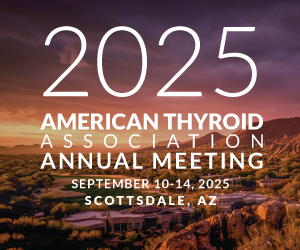
Keeping an Eye Out for Thyroid Eye Disease
Matthew Ettleson, MD
University of Chicago Medicine
Chicago, IL
March 16, 2021
The illustrative example of proptosis may be one of the more memorable images in the medical school textbook, but often the more subtle signs and symptoms of thyroid eye disease (also known as Graves’ orbitopathy or ophthalmopathy) can be overlooked. While severe thyroid eye disease is uncommon, up to 40% of patients with Graves’ disease have some signs or symptoms of thyroid eye disease (1). Most patients with mild eye disease have stable symptoms, but those that develop moderate-to-severe disease may benefit from more aggressive therapies, including glucocorticoids and anti-insulin-like growth factor-1 receptor (IGF-1R) therapy.
The diagnosis of thyroid eye disease relies on a focused history and exam of the eyes. Patients may complain of dry eyes or grittiness, excessive tearing, pain with eye movements and blurry or double vision. Patients may present classically with proptosis and lid retraction, but also redness and swelling of the eye lids or conjunctiva may be present. If several of these findings are present, it suggests the patient has active eye disease and thus may be more responsive to medical therapy. Any concern for visual impairment should prompt urgent evaluation by an endocrinologist and ophthalmologist for a more detailed assessment.
What are first steps to take once the diagnosis of thyroid eye disease is made? The patient’s thyroid function should be assessed and, if abnormal, should be treated promptly. Both hyperthyroid and hypothyroid states can contribute to worsening eye disease. For a patient with newly diagnosed Graves’ disease, this usually begins with antithyroid medication followed by more definite therapy, as discussed in the prior blog post by Dr. Oltmann. It is important to note that radioactive iodine (RAI) therapy has been associated with worsening of thyroid eye disease. Thus, RAI therapy should not be given to those with moderate-to-severe eye disease (2). Cigarette smoking has also been associated with progression of eye disease. For some patients, recognizing that smoking leads to worsening eye symptoms may help convince them it’s finally time to quit!
For patients with mild eye disease, local symptom management is key. Treatment strategies include artificial tears, cool compresses, humidifiers, and sunglasses for protection on excessively sunny or windy days. In over 50% of patients with mild eye disease at the time of diagnosis of Graves’ disease, symptoms will resolve over the following 1-2 years (3).
For those with active, moderate-to-severe disease, a course of pulse doses of IV methylprednisolone is first-line therapy, and can be safely done in the clinic. Often, patients will show improvement within the first 4 weeks of treatment, and most will have a good response after 6 months of therapy. Rarely, long-term glucocorticoid therapy is necessary to prevent clinical worsening. The most promising new therapy for moderate-to-severe disease is teprotumumab, a monoclonal antibody against IGF-1R. Teprotumumab was tested in two clinical trials demonstrating significant improvement in those with severe, active eye disease and was recently approved by the FDA for severe thyroid eye disease (4). In patients who do not respond to glucocorticoids, orbital decompression surgery may be necessary. Finally, after thyroidectomy for definitive treatment of Graves’ disease, there can be thyroid eye disease regression in the year following surgery. Therefore, patients may be able to avoid orbital decompression surgery.
Thyroid eye disease is a common complication of Graves’ disease and can contribute significantly to the morbidity of the disease. However, when recognized, thyroid eye disease in most cases can be treated effectively. This is why it’s so important to keep an eye out for thyroid eye disease!
References:
1. Chin YH, Ng CH, Lee MH, Koh JWH, Kiew J, Yang SP, Sundar G, Khoo CM 2020 Prevalence of thyroid eye disease in Graves’ disease: A meta-analysis and systematic review. Clin Endocrinol (Oxf) 93:363-374.
2. Ross DS, Burch HB, Cooper DS, Greenlee MC, Laurberg P, Maia AL, Rivkees SA, Samuels M, Sosa JA, Stan MN, Walter MA 2016 2016 American Thyroid Association Guidelines for Diagnosis and Management of Hyperthyroidism and Other Causes of Thyrotoxicosis. Thyroid 26:1343-1421.
3. Tanda ML, Piantanida E, Liparulo L, Veronesi G, Lai A, Sassi L, Pariani N, Gallo D, Azzolini C, Ferrario M, Bartalena L 2013 Prevalence and natural history of Graves’ orbitopathy in a large series of patients with newly diagnosed graves’ hyperthyroidism seen at a single center. J Clin Endocrinol Metab 98:1443-1449.
4. Kahaly GJ 2020 Management of Graves Thyroidal and Extrathyroidal Disease: An Update. J Clin Endocrinol Metab 105.
Disclaimer:
The ideas and opinions expressed on the ATA Blogs do not necessarily reflect those of the ATA. None of the information posted is intended as medical, legal, or business advice, or advice about reimbursement for health care services. The mention of any product, service, company, therapy or physician practice does not constitute an endorsement of any kind by ATA. ATA assumes no responsibility for any injury or damage to persons or property arising out of or related to any use of the material contained in, posted on, or linked to this site, or any errors or omissions.



